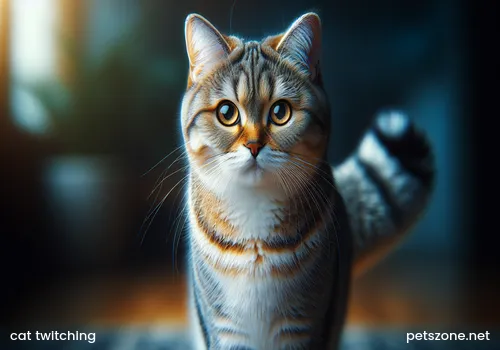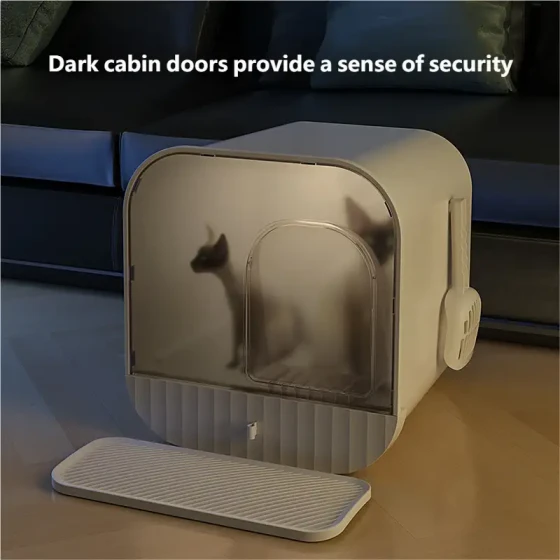How Do Cats Twitch_ Revealing Cats’ Magical Fur Twitching Technique
How do cats twitch? Revealing the cat’s magical “skin surfing”
Have you ever observed your cat’s back suddenly ripple like an electric current passing through, with the skin and fur surfing in waves from shoulder to tail? This phenomenon is vividly called “cat twitch” among cat owners. It sounds like the sound of wind blowing through the fur, but in fact, it is an involuntary response of the cat’s body. What exactly is this magical “fur twitching technique”? Most of the time, “cat twitch” is a completely normal physiological phenomenon, a way the cat perceives external stimuli. Their sensitive nervous system reacts to touch, temperature changes, or even air flow, manifested by quick contractions of the skin muscles. However, occasionally, frequent twitching or twitching accompanied by other symptoms may be a subtle signal from the body that requires more attention.

The true nature of “cat twitch”: More than just skin moving
When we talk about “cat twitch,” what we see is the cat’s back skin undulating like water waves. More precisely, this is the cat’s “skin twitch reflex” (Panniculus reflex), also known as the “cutaneous trunci reflex.” This reflex is caused by the quick, involuntary contraction of the subcutaneous muscles. The cat’s skin is extremely sensitive, full of receptors connected to the nervous system. When a stimulus is received, the nervous system quickly sends commands causing the subcutaneous muscles to contract rapidly, producing visible “wave” effects.
You can imagine it like how our own skin twitches involuntarily when bitten by a mosquito or something brushes past; the cat’s “cat twitch” is a similar mechanism, but due to the structure of their skin and subcutaneous muscles, the twitching looks more obvious, especially on the back area.
Why do cats twitch? Revealing possible reasons
There are many reasons for “cat twitching,” most of which are harmless, but understanding the background helps us better interpret the cat’s behavior and health status.
-
Normal physiological reflex: Sensitive skin is the cat’s “radar”
The cat’s skin is an important organ for sensing its surroundings. Even a tiny stimulus, like you gently stroking its back, a stray hair landing on it, or a sudden temperature change in the room, can trigger this reflex. It’s like the “radar” on the cat’s skin receiving a signal, and the body makes a quick reaction to quickly shed or detect these tiny stimuli. This is the most common and least worrisome situation. -
Removing attachments: Like shaking off dust
If something lands on the cat, such as a leaf, a speck of dust, or even a small bug, it may use “cat twitch” to try to shake these things off. This behavior is similar to the body shake cats do when grooming but may be more localized and rapid. -
Stress, anxiety, or excitement: Emotional “weather gauge”
A cat’s emotions can also be expressed through physical reactions. When feeling stressed, anxious, or extremely excited, some cats show skin twitching. This might be a physical release of their nervous tension or a physiological preparation before certain activities (like suddenly sprinting “parkour”). If you notice “cat twitching” often happens under certain environments or situations (for example, before a vet visit or when strangers come home), it is likely related to emotions. -
Skin discomfort or parasites: Tiny pests can also cause twitching
If the cat’s skin is itchy, dry, allergic, or infested with fleas, mites, or other parasites, it also causes strong skin discomfort, triggering frequent “cat twitch” reflexes. Imagine feeling itchy yourself—you would want to scratch or shake. If your cat frequently licks, bites a specific area, or if the skin shows redness, swelling, or dandruff besides twitching, it’s likely a skin problem or parasites and requires timely examination. -
Feline Hyperesthesia Syndrome (FHS): A signal requiring caution
This is a relatively rare but important condition to pay attention to. FHS is a neurological disorder where affected cats become hypersensitive to touch and may exhibit frequent, intense skin twitching resembling continuous “cat twitch.” Cats with FHS may also show other behavioral abnormalities like sudden sprints, hallucinating licking (licking at the air), extreme tail tip sensitivity or self-attacking their tail, dilated pupils, abnormal vocalization, and more. If your cat’s twitching is very frequent, intense, and accompanied by these unusual behaviors, be sure to take it to the vet for diagnosis.
When should you take your cat to the vet?
Although most “cat twitch” episodes are normal, some situations require our vigilance and timely consultation with a professional vet:
- “Cat twitch” is abnormally frequent or continuous.
- “Cat twitch” is accompanied by signs of pain, such as the cat avoiding touch, vocalizing, or showing aggression during skin twitching.
- The cat excessively licks, bites, or scratches a specific area.
- Visible skin issues appear, such as redness, rash, hair loss, dandruff, or flea feces (small black dots).
- “Cat twitch” occurs along with other abnormal behaviors, like sudden sprints, chasing the tail, dilated pupils, poor appetite, or lethargy.
- You are concerned about your cat’s twitching behavior even without obvious abnormalities. It’s better to make an extra visit for peace of mind.
How to observe and understand your cat’s “cat twitch”
As responsible cat owners, we can do some things to better understand our cat’s “cat twitch”:
- Observe the timing: Did it happen when the cat was woken up by you during sleep? Or when you were playing and exciting it? Or during grooming? Record the timing and environment.
- Observe duration: Was it a brief few seconds? Or did it last a while?
- Observe accompanying behaviors: What else is the cat doing when twitching? Any licking, biting, scratching? Is the cat tense or excited?
- Regularly check the skin: Gently part the cat’s fur and check for redness, rash, parasite signs, or other abnormalities.
- Provide a safe and comfortable environment: Reduce cat stress sources and provide enough play and hiding spaces to help alleviate discomfort caused by anxiety.
- Regular deworming: Follow vet recommendations for internal and external parasite prevention to avoid skin problems caused by parasites.
Frequently Asked Questions
-
Q: Is “cat twitch” normal?
A: In most cases, it is a normal physiological reflex, a response to external stimuli or emotions. -
Q: When should I worry about “cat twitch”?
A: When twitching becomes abnormally frequent, continuous, is accompanied by pain signs, excessive licking or biting, skin abnormalities, or behavior changes, alertness and vet consultation are needed. -
Q: What is the relationship between “cat twitch” and Feline Hyperesthesia Syndrome (FHS)?
A: FHS is a potential cause for frequent and intense twitching but not all twitching means FHS. FHS usually accompanies other neurological or behavioral symptoms. -
Q: How to distinguish normal “cat twitch” from health problems?
A: Observe frequency, duration, and if other symptoms (pain, skin issues, behavior change) are present. If unsure, consult a vet.
Conclusion
In summary, “cat twitch” is a common and fascinating phenomenon in the cat world. Most of the time, it is a normal way healthy cats react to their surroundings and part of their sensitive body. Next time you see your cat’s back performing “skin surfing,” observe the situation—it might be shaking off something on its body or simply responding to your affection. However, if this twitching behavior becomes abnormal, frequent, intense, or comes with other worrying symptoms, don’t hesitate to take it to the vet to get professional answers and ensure your furry friend’s health and happiness! After all, their health and happiness are every cat owner’s greatest wish.
References
- Physiology introduction to cat skin twitch reflex. (Based on search results about Panniculus reflex)
- Description of symptoms of Feline Hyperesthesia Syndrome (FHS). (Based on search results about FHS)
- Veterinary information discussing the relationship between skin irritation, parasites, and cat skin twitching. (Based on search results about skin problems causing cat twitching)
- Information on the effects of emotions on cat physical responses. (Based on search results about stress, anxiety, and cat behavior)



